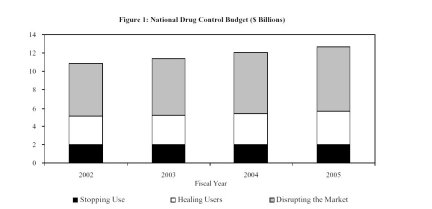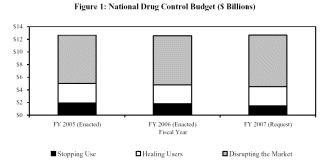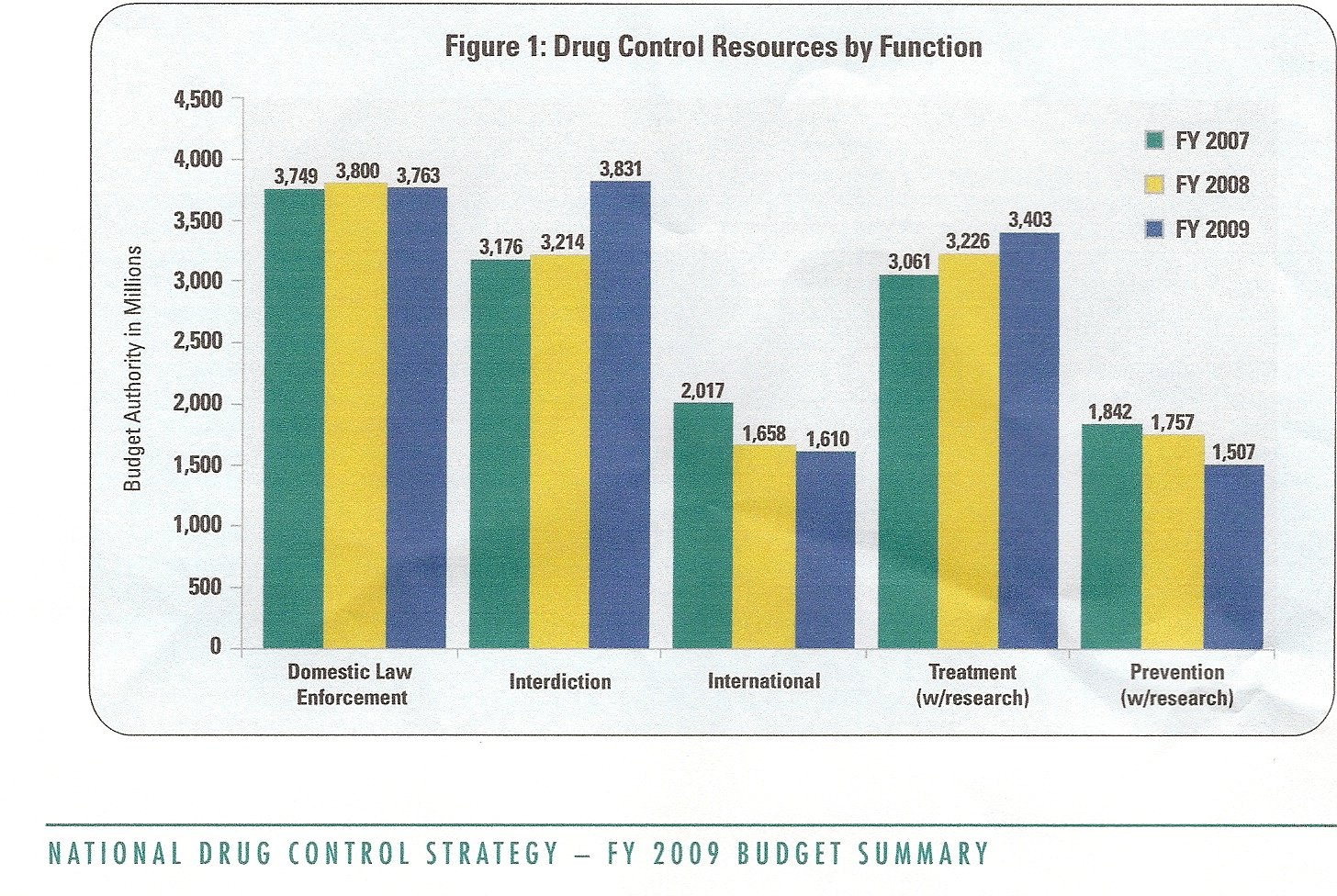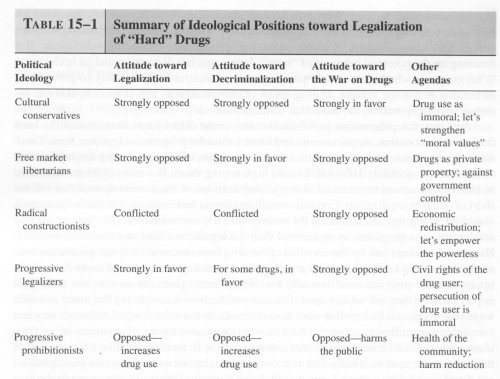![]()

![]()
WWW Links:
![]()
World Drug Report
![]()
| 1906 | Pure Food and Drug Act | Regulates food production,"The Jungle," clamps down on misrepresentation, institutes content labeling, decline of "patent medicines," Beginning of government regulation |
| 1912 | Sherly Amendment | Focus on effectiveness |
| 1914 | Harrison Narcotics Act | Regulates Production, Importation, Distribution, and Use of Opiates. Department od treasury: Narcotics Division established |
| 1922 | Narcotic Drug Import and Export Act (Jones -Miller Act) | Intended to eliminate use of narcotics except for legitimate medicinal use. Establishes: Federal Narcotics Control Board (Still Treasury Department) |
| 1924 | Heroin Act | Makes it illegal to manufacture heroin |
| 1929 | Focus shift to curing addiction (Linder Case 1925) | Federal Hospitals in Lexington and Fort Worth for Narcotic Addiction |
| 1930 | Issue of Corruption in Narcotics Board | Bureau of Narcotics (Harry Anslinger) |
| 1937 | Marijuana Tax Act | Applies controls over marijuana similar to narcotics |
| 1938 | Food, Drug and Cosmetic Act | FDA given control over drug safety, Drugs redefined:effect body even in absence of disease, Establishes class of drugs available by Prescription (Company determines status) |
| 1942 | Opium Poppy Control Act | Prohibits growing poppy w/o license |
| 1951 | Durham-Humphrey Amendment | Established more specific guidelines for prescription drugs: habit forming, safety, and evaluation of new drugs |
| 1951 | Boggs Amendment to the Harrison Narcotic Act | Mandatory sentences for narcotic violations |
| 1956 | Narcotics Control Act | Intends to impose even more severe penalties for narcotics violations |
| 1965 | Drug Abuse Control Amendments (DACA) | Strict controls over amphetamines, barbiturates, LSD, etc. (Bureau of Narcotics and dangerous Drugs) |
| 1966 | Narcotic Addict Rehabilitation Act (NARA) | Allows treatment as an alternative to jail |
| 1968 | DACA Amendments | Provides that sentence may be suspended and record expunged if no further violations within 1 year |
| 1970 | Comprehensive Drug Abuse and Control Act | Replaces and updates all previous laws concerning narcotics and other dangerous drugs. Emphasis on law enforcement. |
| 1972 | Drug Abuse Office and Treatment Act | Establishes federally funded programs for prevention and treatment |
| 1973 | Methadone Control Act | Regulates methadone licensing |
| 1973 | Heroin Trafficking Act | Increases penalties for distribution |
| 1973 | Alcohol, Drug Abuse, and Mental Health Administration (ADAMHA) | Consolidates NIMH, NIDA, and NIAAA under umbrella organization |
| 1973 | Drug Enforcement Administration (DEA) | Remodels Bureau of Narcotics and Dangerous Drugs into DEA |
| 1974 and 1978 | Drug Abuse Treatment and Control Amendments | Extends 1972 act |
| 1978 | Alcohol and Drug Abuse Education Amendments | Sets up education programs within Department of Education |
| 1980 | Drug Abuse Prevention, Treatment, and Rehabilitation Amendments | Extends prevention education and treatment programs |
| 1984 | Drug Offenders Act | Sets up special programs for offenders and organizes treatment |
| 1986 | Analogue (Designer Drug) Act | Makes use of substances with similar effects and structure to existing illicit drug illegal |
| 1988 | Anti-Drug Abuse Act | Establishes oversight office: National Drug Control Policy |
| 1992 | ADAMHA Reorganization | Transfers NIDA, NIMH, and NIAAA to NIH and incorporates ADAMHA's programs into the Substance Abuse and Mental Health Services Administration (SAMHSA) |
![]()
Fiscal Year | Total | ||||
Inflation - Adjusted Dollars in Millions (base year = 1998) | |||||
1981 | 2,747.0 | 745.3 | 788.3 | 292.1 | 921.3 |
1982 | 2,903.4 | 802.8 | 965.2 | 281.4 | 854.0 |
1983 | 3,268.4 | 1,084.9 | 960.0 | 324.9 | 898.6 |
1984 | 3,707.3 | 1,157.0 | 1,307.8 | 329.1 | 913.4 |
1985 | 4,167.1 | 1,414.6 | 1,442.0 | 363.3 | 947.2 |
1986 | 4,284.8 | 1,597.4 | 1,379.1 | 362.9 | 945.4 |
1987 | 6,876.3 | 2,503.4 | 2,322.5 | 863.6 | 1,186.8 |
1988 | 6,486.7 | 2,745.5 | 1,668.0 | 877.0 | 1,196.7 |
1989 | 8,759.5 | 3,629.9 | 2,363.6 | 1,256.7 | 1,509.3 |
1990 | 12,170.7 | 5,284.7 | 2,889.5 | 1,952.6 | 2,043.9 |
1991 | 13,113.7 | 5,248.6 | 3,309.5 | 2,308.9 | 2,246.7 |
1992 | 13,837.2 | 5,742.8 | 3,159.2 | 2,373.8 | 2,561.4 |
1993 | 13,729.3 | 6,421.2 | 2,450.8 | 2,317.6 | 2,539.9 |
1994 | 13,401.2 | 6,492.6 | 1,941.2 | 2,329.2 | 2,638.3 |
1995 | 14,172.9 | 7,226.9 | 1,819.2 | 2,247.4 | 2,879.2 |
1996 | 13,977.0 | 7,443.5 | 1,792.4 | 2,088.2 | 2,653.1 |
1997 | 15,267.4 | 7,804.1 | 2,329.9 | 2,334.3 | 2,799.1 |
1998 | 16,097.3 | 8,254.2 | 2,363.5 | 2,659.7 | 2,819.9 |
Dollars in Millions (unadjusted for inflation) | |||||
1981 | 1,531.9 | 415.6 | 439.6 | 162.9 | 513.8 |
1982 | 1,718.9 | 475.3 | 571.4 | 166.6 | 505.6 |
1983 | 1,997.1 | 662.9 | 586.6 | 198.5 | 549.1 |
1984 | 2,363.1 | 737.5 | 833.6 | 209.8 | 582.2 |
1985 | 2,750.8 | 933.8 | 951.9 | 239.8 | 625.3 |
1986 | 2,881.1 | 1,074.1 | 927.3 | 244.0 | 635.7 |
1987 | 4,792.3 | 1,744.7 | 1,618.6 | 601.9 | 827.1 |
1988 | 4,707.8 | 1,992.6 | 1,210.2 | 636.5 | 868.5 |
1989 | 6,663.7 | 2,761.4 | 1,798.1 | 956.0 | 1,148.2 |
1990 | 9,758.9 | 4,237.5 | 2,316.9 | 1,565.7 | 1,638.9 |
1991 | 10,957.6 | 4,385.6 | 2,765.4 | 1,929.3 | 1,877.3 |
1992 | 11,910.1 | 4,943.0 | 2,719.2 | 2,043.2 | 2204.7 |
1993 | 12,171.1 | 5,692.4 | 2,172.6 | 2,054.6 | 2,251.6 |
1994 | 12,184.4 | 5,903.2 | 1,764.9 | 2,117.7 | 2,398.7 |
1995 | 13,251.2 | 6,756.9 | 1,700.9 | 2,101.3 | 2,692.0 |
1996 | 13,454.0 | 7,164.9 | 1,725.3 | 2,010.0 | 2,553.8 |
1997 | 15,033.2 | 7,684.4 | 2,294.2 | 2,298.5 | 2,756.2 |
1998 | 16,097.3 | 8,254.2 | 2,363.5 | 2,659.7 | 2,819.9 |
2005 Federal Anti-Drug Budget (executive summary)

2007 Federal Anti-Drug Budget (executive summary)

FY 2009 Federal Anti-Drug Budget (executive summary)

2009--Change? (local copy)
Budget for FY 2015 (local copy)
National Drug Control Strategy for 2010 (critique (local copy))
National Drug Control Strategy for 2012 (critique (local copy))
National Drug Control Strategy for 2014 (local copy)
Drug Busts and Drug Control Budgets 1970-2012
Source Control
- Profit (Jamaica-$1 billion, dealers: millions a month, POWER)
- Traditional enterprise in many lessor developed countries
- Issue of Imperialism and Neo-Colonialism
- Shift to domestic production
- Little land area is needed: Coca production needs less than 1000 square miles- 2,500,000 square miles available; Entire U.S. supply of heroin could be produce in only 50 square miles of opium fields (5% of opium production)
- If cultivation is controlled, still have the reality of synthetic production
- Heroin in Afghanistan: Enforcing drug laws versus a heroin-based economy? In 2007
- Cocaine Control? (local copy)
- Push-down/Pop-up
- Mexican Drug Wars, 2010
Domestic Control
Increase Penalties
(Source: FBI, The Uniform Crime Reports (UCR) and http://www.bjs.gov/content/dcf/enforce.cfm)
- 2002: Cost of "War on Marijuana."
- 2003 Marijuana Arrests
- War on Drugs Shifts to War on Marijuana ("A study of FBI arrest and conviction data by a Washington think-tank has underscored a dramatic shift in US drug policy in the decade of the 1990s. "The War on Marijuana: The Transformation of the War on Drugs,", released Tuesday by the Sentencing Project, reports that from 1992 to 2002, the proportion of drug arrests involving marijuana increased from 28% to 45% of all drug arrests, while arrests for the much more dangerous cocaine and heroin decreased from more than half of all drug arrests to less than 30%. " http://stopthedrugwar.org/chronicle/385/shifted.shtml 5/6/05)
- Drug War Facts and BJS data
![]()
![]()
see also: Between Politics and Reason- The Drug Legalization Debate, Erich Goode, 1997.
![]()
The origins and future of the Dutch approach towards drugs
by Justus Uitermark
This paper considers the roots of the Dutch approach towards drugs. It argues that the idiosyncratic nature of Dutch drug policies can be explained by taking into account the peculiar evolution of the Netherlands ’ political institutions. The distinctive character of Dutch policies is explained through the concept of gedogen. Gedogen refers to the practice of discriminatory enforcement. Gedogen can be defined as a regulatory system of organized toleration and targeted repression. Only those illegalities that are actually considered to cause social problems are targeted for repression. As such, the policy differs markedly from orthodox prohibitionist policy approaches. Policies towards ecstasy and cannabis are discussed to illustrate how gedogen works in practice. While it is argued that gedogen has functioned well for a number of years, doubts are expressed about the extent to which the Netherlands can be expected to continue to play the role of pioneer with respect to drug policies. After a revival of conservative politics, the country now seems ill equipped to develop alternative drug policies.
<http://www.cedro-uva.org/lib/uitermark.origins.html>
![]()
![]()
![]()

(from Goode, 2005, page 442)
![]()
URL: http://www.umsl.edu/~keelr/180/law.html
Owner: Robert O. Keel rok@umsl.edu
References and Credits for this Page of Notes
Last Updated: Friday, April 2, 2021 11:43 AM